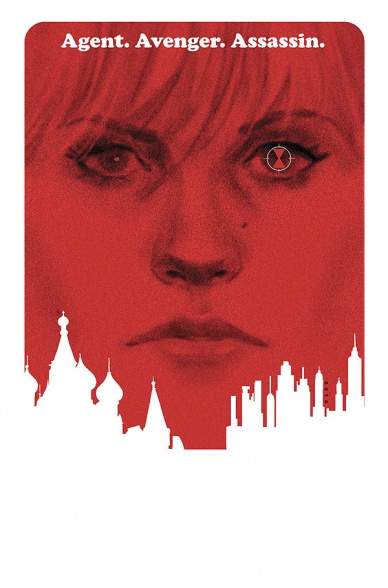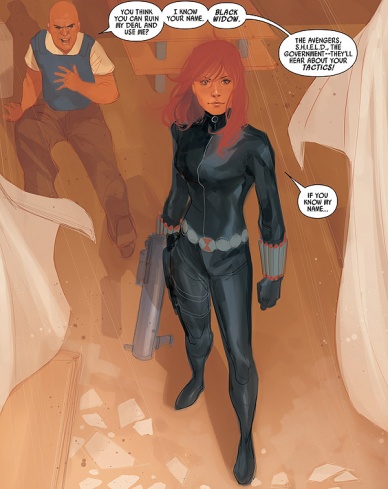
“But [it] is the unteachable skill to belong anywhere. The other edge of that is the unfortunate truth: you must first belong nowhere.”–Natasha RomanovForget everything known about Natasha Romanov’s past. If you want to know anything about Black Widow, Edmondson, Noto, and Cowles show us all we need to know — her work. In Black Widow’s latest solo series, no time is wasted in trying to unveil information, or explain to us readers who Natasha is, nor why she is atoning for her past. Instead of spending time on her evil origins, we jump right into following her on a typical work-week — escaping and exploding through streets and elevator shafts and ships on the high seas of Shanghai, Dubai, Central Park, Paris, Ukraine, Moscow, and Cape Town — because that is who Natasha is.
“Black Widow, Volume 1: The Finely Woven Thread” is a trade to own on every crime-fighter’s shelf as it pushes Natasha to the ends of her ability to be completely trusted and completely invisible to all of her alliances. Can her past help her see the devil in the details? “Black Widow: Volume 1: The Finely Woven Thread” asks us how far can Natasha be trusted, when the people she expects to hunt come from the very same hidden past that she has yet to confront herself.
The structure is golden, a Bond-like mission-to-mission story-line. Its issues can easily stand-alone, but by following S.H.I.E.L.D’s favorite secret weapon/ex-KGB assassin the Black Widow through these stories, we begin to connect to Natasha in the only way possible, in the way the same way she connects to herself: through her work.
“I’m cold hearted,” Natasha says, as if that is a fault, and not a relief. Unlike other female superheroes, there is no need to care for others above herself. There are no external forces fighting for our attention or tempting Natasha away from work. No lovers. No need to quit the one thing that no one else can do because society thinks poorly of her life choices. Each issue can stand alone as the conflict of this story comes from finishing her job, and not on external plot-lines of other people in her story– although we do get to meet a black cat named Litho that she takes care of but refuses to call hers, even though her neighbor does. Litho, like Natasha, is a loyal stray that Natasha, going off the knowledge she has of this know animal, lets her stick around for now, for home.
Or, as some readers have been clever to assume, Litho provides a Capote-like reference-“Poor Cat! Poor slob!” But unlike Capote, this cat very much has a name that Natasha does give to it, and in that way we see Natasha’s sense of rooted self, unlike the resentful leading lady of his stories. She has a case of the reds that fit her just fine.

Edmondson’s writing shines in his ability to convey information, while usurping our expectations of what should happen based on what we think we know about Black Widow. In the opening scene of the series we see Natasha “confiding” her past to a man behind a door with explosives, in order to elicit his trust. We can see the allusions in her confession towards theories of Black Widow’s past, but it is misdirection; it is a trick to help Natasha finish her job. It is also one of many choices that Edmondson makes to create a striking tale that pokes fun at all expectations us readers have of Black Widow’s mysterious past, and the espionage genre.
There are no cheap reveals. There are only stakes, and costs. There are alliances formed and S.H.I.E.L.D working to use Natasha towards its own aims, and there is the thrill of seeing how Natasha can complete a mission without compromising her values.
Another relief is that Edmondson doesn’t hinge Natasha’s development on being a hero’s confessional story, portraying some vulnerable part of herself (as femme fatales are often portrayed). The closest thing we get to a moral compass, or moral side-kick, or partner, is Isaiah — her sardonic lawyer/manager of funds — but he provides more of an “M” relationship to Natasha than an antagonistic one bent on breaking her to some humane mess of tears and jadedness. Not even Hawkeye, even though he can’t help but make a crashing cameo into her tale, can take the focus off of our leading lady. She’s the woman who could snap your neck with her thighs; she’s the woman who could knock out an abusing husband, but is incapable of wiping away a spider web dangling from her kitchen sink with the spider still attached. She’s an altruistic hit-man. A killer, but not a murderer, hell-bent on getting work without charging fees. She is bored with the Avengers, but needs the work to keep from going broke.
Continued belowShe’s got enough story in her own life to tell us — and though her past is left unanswered, its demons can’t help but track Natasha down.
In a story of uncovering truths and confronting them, Noto’s rendering of Black Widow is pitch-perfect; hazy, yet gritty. Noto doesn’t glam up Black Widow in shiny pleather or cartoonish tones or excessive cleavage. His settings are blurred and precise, balancing the desire to have clarity in situations where there can’t actually be simple lines drawn. To his success, Noto uses minimal ink and sketchy outlines of people set in monochromatic tones. The background is distant, while simultaneously focusing on fine details of characters’ faces, letting us readers grapple with who people are vs. how they appear in their setting.
Noto also plays with our expectations. Never falling into a predictable pattern, Noto keeps the shots of Natasha in full-range motion and tension. Sometimes her body is rolling between panels, or taking up an entire page free-falling, or looking into an eye that is a sniper-lens reflecting back onto a greened out vision of her killing past. Noto rocks at creating thrill, and releasing Natasha from predictable panels of BAM, SNAP, CRACK, though she does get to throw in those bone-breaking punches too.

Cowles’ lettering is sensible, and terse. The choice to portray her thought bubbles in a red back-drop with white lettering over darkened background lets us easily spot her thoughts when we need to hear what she thinks. Her moves are left to speak for themselves, and not cluttered in lettering, thus creating natural breaks that allow us to watch first, then listen closely.
“Black Widow, Volume 1: The Finely Woven Thread” started on a leap out of a hi-rise building, and it stops asking how the hell this tale can continue. But, if it doesn’t stop to question its ability to mislead and challenge our expectations of how Natasha should be and who she should answer to, the story will continue to amaze us as we see who she is by what she chooses. We readers need a woman hero that doesn’t have to be okay or have to feel good to do good. “I have always had a home,” Natasha confides, “Even if it is not apparent to me or anyone else. Home is where the hurt is… but… only until the pain subsides.”
She is a character that can only stay inside until she’s mended enough to break herself under the hammer of/for humanity — because, let’s face it, who else can?
Final Rating: 9.5 – A strong first outing starring an amazing character



